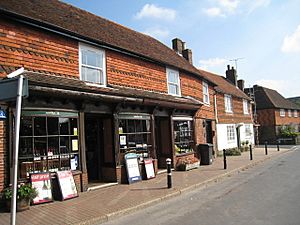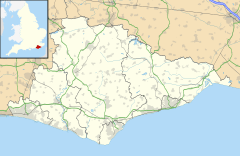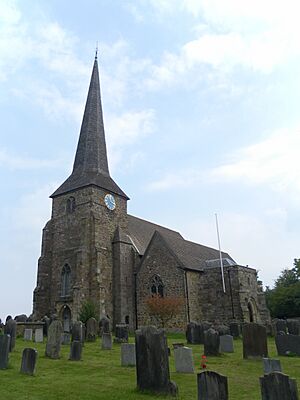Wadhurst facts for kids
Quick facts for kids Wadhurst |
|
|---|---|
| Market town | |
 Shops on Church Street |
|
 Flag of Wadhurst |
|
| Area | 40.1 km2 (15.5 sq mi) |
| Population | 4,883 (Parish-2011) |
| • Density | 311/sq mi (120/km2) |
| OS grid reference | TQ640318 |
| • London | 36 miles (58 km) NNW |
| District |
|
| Shire county | |
| Region | |
| Country | England |
| Sovereign state | United Kingdom |
| Post town | WADHURST |
| Postcode district | TN5 |
| Dialling code | 01892 |
| Police | Sussex |
| Fire | East Sussex |
| Ambulance | South East Coast |
| EU Parliament | South East England |
| UK Parliament |
|
| Website | Wadhurst Parish Council |
Wadhurst is a small market town located in East Sussex, England. It is the main part of a larger area called the civil parish of Wadhurst. This parish also includes smaller villages like Cousley Wood and Tidebrook. Wadhurst has a special friendship with Aubers, a town in France, as they are 'twinned'.
Contents
Where is Wadhurst Located?
Wadhurst is found on the border between Kent and Sussex. It is about 11 kilometers (7 miles) east of Crowborough. It is also about 11 kilometers (7 miles) south of Royal Tunbridge Wells. Other towns nearby include Ticehurst, Burwash, Mayfield, and Heathfield in East Sussex. In Kent, you can find Lamberhurst, Hawkhurst, and Cranbrook close by.
Wadhurst sits on a high ridge of the Weald. The Weald is a range of wooded hills that stretch across Sussex and Kent. The large Bewl Water reservoir is also nearby. The River Bewl and the Limden River both start within the Wadhurst parish area.
A Look at Wadhurst's History
How Wadhurst Got Its Name
The name Wadhurst comes from Anglo-Saxon times. Early records show it as "Wadeherst." It likely comes from "Wada," who was probably the leader of a Saxon tribe. This tribe settled in the area in the 7th or 8th century. They started clearing the forests to build their homes. There was also an Anglo-Saxon manor called Bivelham between Wadhurst and Mayfield.
Early Records and Royal Charters
Wadhurst was almost certainly around during the Domesday Book survey in 1086. However, it was part of the Archbishop of Canterbury's land, so it wasn't mentioned in the survey. The first known record of the area talks about "Snape in the parish of Wadhurst." This was found in the Cartulary of Battle Abbey.
In 1253, King Henry III gave Wadhurst its special charter. This allowed the town to hold a market every Saturday. It also allowed a fair on June 29th, which is the feast day of St Peter and St Paul.
Wadhurst's Iron Industry
During the 16th, 17th, and 18th centuries, Wadhurst was a busy place for the iron industry. Many towns and villages in the Weald had this industry. Two large Georgian buildings on the High Street, Hill House and The Old Vicarage, were homes for ironmasters. Other big houses on the edge of Wadhurst were also owned by ironmasters. Inside the church of St Peter and St Paul, you can find special iron memorial stones. These stones are unique to this area and honor the ironmasters.
Wadhurst During World War I
During the First World War, Wadhurst lost many young men. Out of a total village population of 3,500, 149 men were killed. The worst losses happened during the Battle of Aubers Ridge. On that single day, 25 men from Wadhurst died. This was almost 80% of the men from Wadhurst who fought in that battle. Today, Wadhurst is twinned with Aubers to remember this shared history.
Wadhurst: A Great Place to Live
In March 2023, a newspaper called The Sunday Times named Wadhurst the best place to live in the United Kingdom.
How Wadhurst is Governed
Wadhurst has an electoral ward (a local voting area) with the same name. In 2011, about 5,181 people lived in this ward.
Buildings and Community Life
Wadhurst is a small market town. It still has a good variety of shops for its size. You can find a traditional butcher, a baker, an ironmonger, a hairdresser, a bank, a post office, and several pubs. In 2020, the estimated population was about 4,025 people.
Important Buildings
There are three buildings in the town that are especially interesting for their architecture. Many old manor houses and farms are also nearby. The Church of St Peter and St Paul is a very old church that stands in the center of town. It shows Wadhurst's history with the iron industry. You can see many iron gravestones inside the church.
On the High Street, there are two early Georgian houses: the Old Vicarage and Hill House. Just outside the town is Wadhurst Castle, which was built in the 19th century. The parish church is from the medieval period. It has parts built between the 12th and 15th centuries. It features a shingled spire and a vaulted porch. Inside, there are 30 special iron tomb slabs from 1614 to 1790.
Most of the other buildings in the town center are in different old styles, some from the 13th century. Not many buildings in the center are very modern. Some shops were built after the Queens Head Hotel was destroyed in 1956.
Transport and Growth
During the Victorian era, the town grew towards the new Wadhurst railway station. This station is about 2.4 kilometers (1.5 miles) north of the town. It is the highest railway station in southern England. The station opened in 1851 and is on the line from London Charing Cross to Hastings. This growth brought smaller areas like Sparrow's Green, Turners Green, and Best Beech Hill into the town. Besides the railway, there are buses to Tunbridge Wells, Crowborough, and Hastings. There are also community transport and 'rail link' buses to Ticehurst and Mayfield.
Churches and Schools
In the center of Wadhurst, there are two churches. St Peter and St Paul is an Anglican church, with parts dating back to the 12th century. Wadhurst Methodist Church is no longer used as a church. There is also a Catholic church in Mayfield Lane, connected to the Sacred Heart School. These churches work together with other local churches in an organization called Churches Together. Church Street has a row of cottages from the 13th and 14th centuries. These are thought to be the oldest buildings in Wadhurst. Some believe they were once part of a cloister for St Peter and St Paul's Church.
There are also two old chapels from the early 19th century in Pell Green and Shover's Green. Both are special Grade II listed buildings.
Wadhurst has two schools that are part of the state system. There's a Church of England primary school (with a nursery) in Sparrow's Green. There is also Uplands Academy, which is a secondary school and sixth form. Uplands Academy also has a youth and community center. In Mayfield Lane, there is an independent Catholic school called Sacred Heart.
Wadhurst United Football Club
Wadhurst United F.C. is the local football team for Wadhurst. They play at the Recreation Ground on South View Road. The club was started in 1890. They joined the Sussex County Football League Division Three in 2004. After the 2005–06 season, they left that league to rejoin the East Sussex Football League. In the 2008–09 season, the club won the East Sussex League Division Two title.
Twin Town
Wadhurst is twinned with Aubers in France. This means they have a special friendship and cultural exchange.
Famous People from Wadhurst
- Jeff Beck: A famous guitarist who lived in Wadhurst from 1975 until his death in 2023.
- William Bidlake: An architect who lived and worked in Wadhurst from 1924 until he passed away.
- Caroline Augusta Foley Rhys Davids: A scholar who studied and translated the Pāli language.
- Davina McCall: A well-known television presenter who lived in Wadhurst until 2019.
- Irfan Orga: A writer from Turkey who lived in Wadhurst from 1961 to 1970.
- Hans Rausing: A billionaire who inherited the company Tetra Pak. He owned a house and a deer park in Wadhurst. His family still owns Wadhurst Park.
- Seymour Whinyates: A British violinist who died in Wadhurst in 1979.
See also
 In Spanish: Wadhurst para niños
In Spanish: Wadhurst para niños




